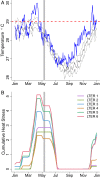Nitrogen pollution interacts with heat stress to increase coral bleaching across the seascape
- PMID: 32094188
- PMCID: PMC7071909
- DOI: 10.1073/pnas.1915395117
Nitrogen pollution interacts with heat stress to increase coral bleaching across the seascape
Abstract
Climate change is increasing the frequency and magnitude of temperature anomalies that cause coral bleaching, leading to widespread mortality of stony corals that can fundamentally alter reef structure and function. However, bleaching often is spatially variable for a given heat stress event, and drivers of this heterogeneity are not well resolved. While small-scale experiments have shown that excess nitrogen can increase the susceptibility of a coral colony to bleaching, we lack evidence that heterogeneity in nitrogen pollution can shape spatial patterns of coral bleaching across a seascape. Using island-wide surveys of coral bleaching and nitrogen availability within a Bayesian hierarchical modeling framework, we tested the hypothesis that excess nitrogen interacts with temperature anomalies to alter coral bleaching for the two dominant genera of branching corals in Moorea, French Polynesia. For both coral genera, Pocillopora and Acropora, heat stress primarily drove bleaching prevalence (i.e., the proportion of colonies on a reef that bleached). In contrast, the severity of bleaching (i.e., the proportion of an individual colony that bleached) was positively associated with both heat stress and nitrogen availability for both genera. Importantly, nitrogen interacted with heat stress to increase bleaching severity up to twofold when nitrogen was high and heat stress was relatively low. Our finding that excess nitrogen can trigger severe bleaching even under relatively low heat stress implies that mitigating nutrient pollution may enhance the resilience of coral communities in the face of mounting stresses from global climate change.
Keywords: Acropora; Pocillopora; climate change; coral reef; nutrient availability.
Conflict of interest statement
The authors declare no competing interest.
Figures





References
-
- Smale D. A., et al. , Marine heatwaves threaten global biodiversity and the provision of ecosystem services. Nat. Clim. Change 9, 306–312 (2019).
-
- Brown B. E., Coral bleaching: Causes and consequences. Coral Reefs 16, S129–S138 (1997).
-
- Lesser M. P., “Coral bleaching: Causes and mechanisms” in Coral Reefs: An Ecosystem in Transition, Dubinsky Z., Stambler N., Eds. (Springer, 2011), pp. 405–419.
-
- LaJeunesse T. C., et al. , Systematic revision of Symbiodiniaceae highlights the antiquity and diversity of coral endosymbionts. Curr. Biol. 28, 2570–2580.e6 (2018). - PubMed
-
- Loya Y., et al. , Coral bleaching: The winners and the losers. Ecol. Lett. 4, 122–131 (2001).

